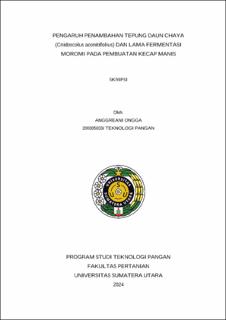Pengaruh Penambahan Tepung Daun Chaya (Cnidoscolus aconitifolius) dan Lama Fermentasi Moromi pada Pembuatan Kecap Manis
The Effect of Adding Chaya Leaf Flour (Cnidoscolus aconitifolius) and Moromi Fermentation Duration on Sweet Soy Sauce Production

Date
2024Author
Ongga, Anggreani
Advisor(s)
Lubis, Linda Masniary
Sinaga, Hotnida
Metadata
Show full item recordAbstract
Chaya (Cnidoscolus aconitifolius) is a member of the Euphorbiaceae family which contain active compounds such as tannins, saponins, alkaloids, cyanogenic glycosides, flavonoids, terpenoids, and phytic acid. Soy sauce is a liquid product resulting from the fermentation and hydrolysis of soybeans. Sweet soy sauce is also a product of soybean fermentation with the addition of brown sugar, sugar through caramelization, or without caramelization. The fermentation of moromi in soy sauce production involves the role of Lactic Acid Bacteria (LAB) utilizing high salt concentrations during hydrolysis. The aims of this research were to determine the effect of adding chaya leaf flour, moromi fermentation time, and the interaction between the addition of chaya leaf flour and moromi fermentation time on soy sauce production. This research design were Factorial Completely Randomized Design (CRD) with two factors: the addition of chaya leaf flour (C) at levels of 0%, 5%, 10%, and 15%; and moromi fermentation time (L) at 1 month, 2 months, and 3 months.
The results indicated that the addition of chaya leaf flour significantly affected (p<0.01) the protein content of moromi, vitamin C content of moromi, pH of moromi, protein content of soy sauce, vitamin C content of soy sauce, pH of soy sauce, color index of soy sauce, ash content of soy sauce, total flavonoid content of soy sauce, and the hedonic taste of soy sauce. The duration of moromi fermentation highly significantly affected (p<0.01) the protein content of moromi, protein content of soy sauce, color index of soy sauce, hedonic taste of soy sauce, and significantly affected (p<0.05) the hedonic aroma of soy sauce. The best treatment determined by the De Garmo method was C4L2, which were the treatment with a 15% addition of chaya leaf flour and a moromi fermentation duration of 2 months.
Collections
- Undergraduate Theses [638]
